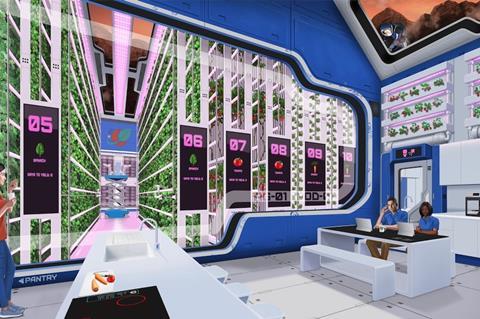UK indoor farming technology could eventually feed humans on the Moon and Mars
UK vertical farming tech outfit Vertical Future (VF) has been awarded a £1.5m grant to deliver the second phase of the Autonomous Agriculture for Space Exploration project.

The initiative will adapt VF controlled-environment-agriculture (CEA) systems to prototype Low Earth Orbit (LEO) growing systems for use in the first commercial space station being constructed by Axiom Space, due in orbit in 2026.
VF designs, manufactures, and deploys intelligent autonomous CEA systems globally with several use cases beyond leafy greens such as pharmaceuticals, nutraceuticals, integration with greenhouses, and research and development for application in outer space.
VF’s proposal was exclusively selected by the UK Space Agency due to its technological expertise and leadership in plant science, the company said. The planned work aligns with the UK’s ambitions for human presence in Low Earth Orbit and beyond.
The initiative is part of the UK Space Agency’s £20m International Bilateral Fund programme, with the project aiming to drive innovation and sustainability while providing a valuable contribution to commercial space exploration and the Artemis Accords.
Earth and beyond
The technologies proven in the work will look beyond the initial LEO plans and expand into the 2030s as a key enabler for Mars missions. Following this, the goal is to implement the solutions onto Lunar Gateway, the Lunar surface, and, eventually, the Martian surface.
VF systems are designed to be adaptable to all environments on Earth. Through the approaches to farm communication and data management in the project, VF will offer the first fully remotely monitored farm system enabling productivity tracking of systems on Earth, in orbit, and on lunar and Martian bases.
Technology development for deployment in space has proven benefits to life on Earth, VF explained. Examples of the over 30,000 commercial applications of space technology that have entered the consumer market since the 1950s include scratch-resistant lenses, the computer mouse, ear thermometers, smoke detectors, cordless tools, and memory foam.
Technologies developed and enhanced in this project are set to improve controlled environment agriculture productivity and operational efficiency and Vertical Future said it is in a position to deploy these immediately on Earth, where climatic shocks and international unrest impact food supply while geographical factors prevent the production of various staple foods nationally.
The project was established via an international collaboration supported by the UK Space Agency, NASA, and the Australian Space Agency (ASA). It brings together fellow World Economic Forum Innovator Axiom Space, mission operations experts Saber Astronautics as well as research partners from the ARC Centre of Excellence in Plants for Space (Universities of Adelaide, Western Australia and Cambridge) and iLAuNCH (University of Southern Queensland), with additional support from South Australian Space Industry Centre (SASIC).
Growing off-planet
Dr Jen Bromley, chief scientific officer and Autonomous Agriculture Project lead at VF, said: “The further we go into space, the more we will need to produce while we’re there, be it food, biomaterials, or medicines. Plants are able to be the biofactories to cover all of these needs.
“The ability to reliably grow off-Earth is not yet realised as the technologies to achieve this haven’t yet been implemented away from Earth at the scale required to sustain life. The autonomous agriculture project puts VF and the UK at the front and centre, leading and defining a new category for the commercial space sector: Agri-Space.
“The skills and sector-specific knowledge brought by our incredible partners are crucial to delivering the project, including sensor development critical to delivering an autonomous growing environment and enabling fine-tuning of parameters that cannot be tested outside of a micro-gravity environment.”



